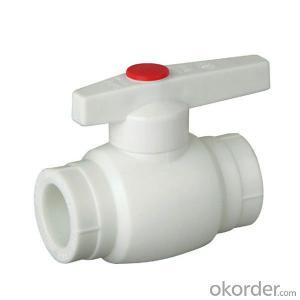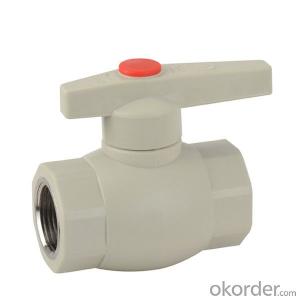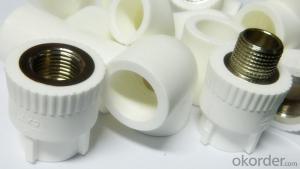Plastic BSP PPR Ball Valve Fittings for Industrial Application
- Loading Port:
- Tianjin
- Payment Terms:
- TT OR LC
- Min Order Qty:
- 1000 pc
- Supply Capability:
- 100000 pc/month
OKorder Service Pledge
OKorder Financial Service
You Might Also Like
Introduction of Products
1) Cold and hot water supply systems for civil and industrial constructions, e.g. in residential buildings, hospitals,
hotels, school and office buildings, ship building
2) Drinking water systems and food industry pipe works
3) Central air conditioning system
4) Irrigating system for gardens and green houses
5) Public and sport facilities such as swimming pools and stadiums
6) For rainwater utilization systems
Size
Normal Sizes for CNBM PPR Pipe | |||||
Outside Diameter(mm) | Wall Thickness(mm) | Package(m/bale) | |||
S5 PN1.25MPa | S4 PN1.6MPa | S3.2 PN2.0MPa | S2.5 PN2.5MPa | ||
20 | 2 | 2.3 | 2.8 | 3.4 | 120 |
25 | 2.3 | 2.8 | 3.5 | 4.2 | 120 |
32 | 2.9 | 3.6 | 4.4 | 5.4 | 80 |
40 | 3.7 | 4.5 | 5.5 | 6.7 | 60 |
50 | 4.6 | 5.6 | 6.9 | 8.3 | 40 |
63 | 5.8 | 7.1 | 8.6 | 10.5 | 24 |
75 | 6.8 | 8.4 | 10.1 | 12.5 | 16 |
Products Show



Feature
1) Healthy, bacteriological neutral, conforming to drinking water standards
2) Resistant to high temperatures, good impact strength
3) Convenient and reliable installation, low construction expenses
4) Excellent heat-insulation property from minimum thermal conductivity
5) Lightweight, convenient to transport and handle, good for labor-saving
6) Smooth inner walls reduce pressure loss and increase flow speed
7) Sound insulation (reduced by 40% compared to galvanized steel pipes)
8) Light colors and excellent design ensure suitability for exposed
Packaging & Delivery
Packaging Details: PE bag + carton
Delivery Detail: 15 Days
FAQ
Q1: How Can I Get a Sample?
A1: You can get samples by communicate with our export sales.
Q2: How Long Is Delivery?
A2: Delivery time will be30-45days according to order quantity.
Q3: What Is The MOQ?
A3: MOQ depends on different items.
Q4: What Is Our Normal Payments Terms?
A4: Our normal payment terms now is: T/T, L/C,D/A,D/P
- Q: Can the PPR pipe be injected with the same pipe as the PVC pipe?
- Used machines look at machine precision. The main view is whether the template is even, and whether the track is worn badly. Second, look at the circuit is chaotic, chaotic, indicating that many times the maintenance, the oil circuit is leaking, leakage, that is already very old.
- Q: How do plastic pipe fittings compare to polyvinylidene fluoride (PVDF) fittings?
- Plastic pipe fittings offer a cost-effective solution for general plumbing applications, while PVDF fittings provide superior chemical resistance and durability in more demanding industrial environments.
- Q: Do plastic pipe fittings have a maximum operating temperature?
- Yes, plastic pipe fittings have a maximum operating temperature. The maximum temperature varies depending on the type of plastic used in the fittings. It is important to consult the manufacturer's specifications to ensure that the fittings are compatible with the intended temperature range.
- Q: How do you repair a broken plastic pipe fitting?
- To repair a broken plastic pipe fitting, the first step is to turn off the water supply to prevent further damage. Then, clean the area around the break with a cloth or brush. Next, use a PVC or plastic pipe cement to carefully apply adhesive to both the broken ends of the fitting and the corresponding pipe. Press the pieces together firmly, ensuring a tight seal. Allow the adhesive to dry completely before turning the water supply back on. It is important to note that if the break is severe or the fitting is extensively damaged, it may be necessary to replace the entire fitting.
- Q: Can plastic pipe fittings be used for hydrogen fuel cell systems?
- No, plastic pipe fittings are not suitable for hydrogen fuel cell systems. Hydrogen is a highly reactive gas that can permeate through plastic materials, leading to potential leaks and safety hazards. In hydrogen fuel cell systems, it is recommended to use specialized fittings made of materials like stainless steel or other high-strength alloys that are compatible with hydrogen.
- Q: What kind of flange gasket does the ABS plastic tube work with?
- Multipurpose; made of the same material as pipes. Elbow (elbow), flange, three pipe and four pipe (crosshead) and reducer (reducer) etc.. Elbow for pipeline corner; flange for the pipe and pipe interconnected parts, connected to the pipe end, three pipe for three pipe collection; four pipe for four tubes together place; for two pipes of different diameters connected to different diameter pipe.
- Q: What is the maximum pressure rating for plastic pipe fittings?
- The maximum pressure rating for plastic pipe fittings can vary depending on the type of plastic material used, the size of the fitting, and the specific application. However, most commonly used plastic pipe fittings have a maximum pressure rating of around 150 psi (pounds per square inch). It is important to refer to the manufacturer's specifications and guidelines for accurate and specific pressure rating information.
- Q: Do plastic pipe fittings require any special threading or grooving?
- No, plastic pipe fittings do not require any special threading or grooving. They are designed to be easily connected using compression or push-fit mechanisms, eliminating the need for threading or grooving like in metal pipe fittings.
- Q: Can plastic pipe fittings be used for elevated water storage systems?
- Yes, plastic pipe fittings can be used for elevated water storage systems. Plastic pipes and fittings are often preferred for such systems due to their lightweight nature, durability, and resistance to corrosion. They can effectively handle the pressure and flow requirements associated with elevated water storage systems. Additionally, plastic pipe fittings are easy to install, cost-effective, and require minimal maintenance.
- Q: Can plastic pipe fittings be used in reverse osmosis systems?
- Yes, plastic pipe fittings can be used in reverse osmosis systems.
Send your message to us
Plastic BSP PPR Ball Valve Fittings for Industrial Application
- Loading Port:
- Tianjin
- Payment Terms:
- TT OR LC
- Min Order Qty:
- 1000 pc
- Supply Capability:
- 100000 pc/month
OKorder Service Pledge
OKorder Financial Service
Similar products
Hot products
Hot Searches
Related keywords


































